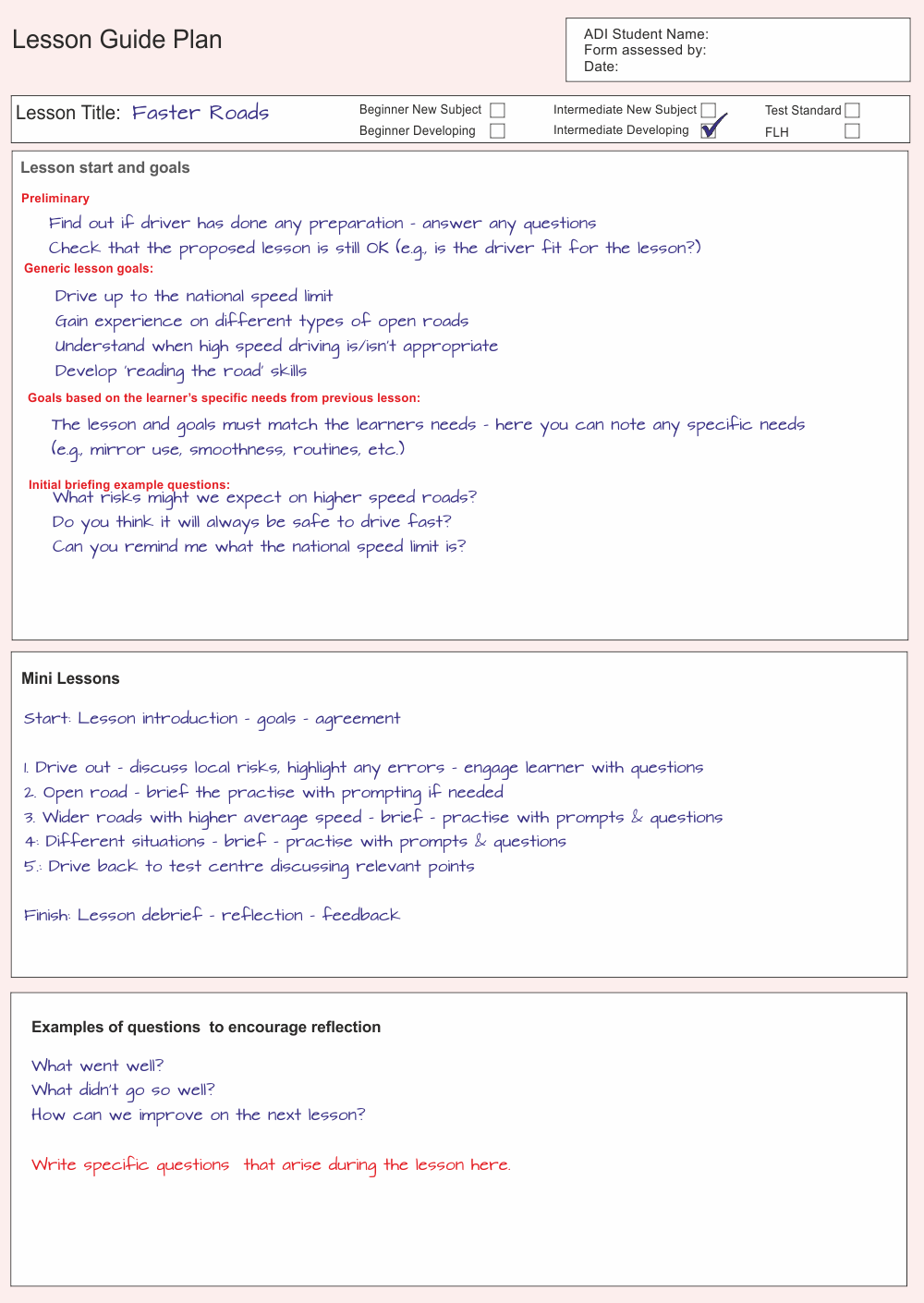


You can use the form below to create basic lesson plans, or, if you prefer, you can create plans yourself from scratch on blank paper or forms that you design for yourself.
The important thing is that your plans include the key information shown.
Lesson plans can be as simple or as complex as you wish - the form shown here, and the information it contains, demonstrates the simple end of the spectrum. We would expect your plans to have this level of detail as a minimum.
Caution: You are not writing a lesson script. You are developing a key-point guide.
You will see that the form follows the information you have been learning about building a lesson and includes provision for each element of the lesson, as explained below. This lesson is shown on the videos in this unit.

Note: We have not included timings on this example - as you gain experience you will be able to approximate the
length of each mini-lesson and add timings to your plan. This will help to keep your lessons on track.
You can download a copy of the form above here and a blank copy here
The form above starts with the 'Lesson Title'. Giving your lesson a name will help to focus your attention.
Next there are tick boxes for information about the driver’s skill level.
Beginner New Subject: Someone in the early stages of learning possibly learning the basics of left and/or right turns, gear changing, steering, meeting other traffic, hill and angle-starts on very quiet roads.
Beginner Developing: This would be a learner who has already been introduced to the subject of the lesson and had some practise. The lesson would be aimed at developing their skill further to allow more independence and/or new situations (same subject, different route).
Intermediate New Subject: An intermediate learner is one who has mastered the basics and is moving on to new hazards, possibly traffic lights, roundabouts, pedestrian crossings, faster roads, etc. The lesson would be aimed at developing their ability to deal with a new hazard type.
Intermediate Developing: This would be a learner who has already been introduced to the subject of the lesson and had some practise. As with developing Beginner lesson, the lesson would be aimed at developing their skill further to allow more independence and/or new situations (same subject, different route). Take care with this type of lesson that there is a clear focus – for example ‘dealing with busier traffic’ is very loose… Whereas, ‘working on following distance and mirror use in busier traffic’ is more specific and will help you to focus more clearly.
Driving Test Standard: This is a learner who is ready for test and needs some final advice to fix any weak areas. If you choose a test standard learner you must ensure that there are very clearly defined goals, otherwise the lesson can drift into a ‘general drive’ which does not give you much opportunity to demonstrate your skills to the examiner.
Full Licence Holder: Full Licence Holders (FLH) might be the most appropriate choice for some ADI Students, simply because, unless you are on a Trainee Licence or have a family member who is learning to drive you might not know or have access to a learner driver. If you choose a FLH it will help to think about your own driving development – what issues and challenges were there for you when training for ADI Part-Two?
The three boxes on the form are where you think about the driver and ‘sketch out’ an overview of the lesson.
First box:
Lesson start and goals
Here you add anything relevant about prior learning, the generic lesson goals.Goals based on the learner’s specific needs from previous lesson:
Goals specific to the pupil and ideas for questions to get started. Note that the goals will be discussed with the learner at the end of the previous lesson and recapped/amended where required, at the start of this lesson.
Initial briefing example questions:
These would mainly be for the exam lesson - to help both you and the learner to 'get started'. As you gain experience and learn more about asking questions, these questions will be spontaneous and will not need to be written down.
Second box:
This sets out the key elements of the lesson.
We suggest that you have separate notes that cover the route and content/goals for each mini-lesson.
Examples of questions to encourage reflection
We have included three generic questions on our form to encourage reflection. However you will almost certainly want to ask about specific aspects of the lesson in addition to these.
Jot down thought/questions as the lesson progresses.
Note: It's always a good idea to have a clipboard and make notes - this way you won't forget anything. Important: Written notes only - you cannot use a phone or tablet to make notes - this would be illegal and could lead to you losing your ADI licence.
Next: An overview of the videos for this lesson plan...